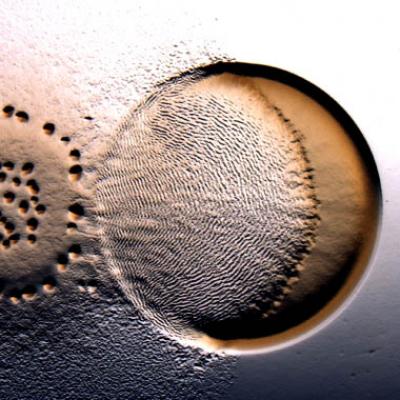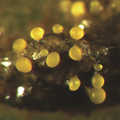Myxococcus xanthus
For the course duration, the article is closed to outside editing. Of course you can always leave comments on the discussion page. The anticipated date of course completion is May 21, 2009. One month after that date at the latest, this notice shall be removed. Besides, many other Citizendium articles welcome your collaboration! |
| Scientific classification |
|---|
|
|
Description and significance
 M. xanthus gliding mechanism during predation
M. xanthus gliding mechanism during predation
[1] Myxococcus xanthus is a social organism, which are self-organized, saprotrophic and predatory. M. xanthus is a rod shaped, gram negative bacteria, which uses a form of gliding for locomotion. There's been recent discovery of two types of systems used for locomotion. The first system is type IV pilli, which is used as a type of hook. The second system is mucus secreting, which tend to form sites of focal adhesion. During starvation periods this bacteria has been discovered to use a form of chemotaxis signaling in order to produce and regulate multi-cellular rippling during predation. Predation takes place a multi-cellular synchronizing mechanism. The ability for this bacteria to communicate with others and be able to work together towards the targeted prey, makes it a good candidate for research. M. xanthus tends to form fruiting bodies. Within these fruiting bodies there are spores. These spores will germinate in order to return to a vegetative cycle as soon as conditions are favorable. M.xanthus is a predator to other bacteria, but harmless to humans.
Genome structure
M.xanthus is one of the largest prokaryotic genomes to be sequenced. Length of genome is 9,139,763 nt. Number of genes: 7456, Protein coding genes: 7331, Structural RNAs: 79, Pseudo genes:43, Topology: circular.
Cell structure and metabolism
M. xanthus has a life cycle which includes; predation, fruit bodies and swarming. Fruit bodies usually form from the cause of starvation, these bodies can then form into stress-resistant spores.
Ecology
M. xanthus is commonly found in soil. This bacteria lives in a multi-cellular unit.
Pathology
This bacteria is a predator of other bacteria, but non pathogenic. The fact that M. xanthus moves by chemotaxis and usually moves towards a prey resulted in the word "predataxis". M. xanthus is not a single unit when attacking a prey, rather there is a sense of cooperation. Predation of M. xanthus includes release of toxic and lytic substances. These substances can degrade or paralyze the targeted prey.
Application to biotechnology
The unique feature of M.xanthus being predatory towards other bacteria, is of great use for studies. This feature has been hypothesis to be utilized in order to predate for other harmful bacteria. Many of the secondary metabolites secreted by M. xanthus are utilized to lyse other soil microbes. One of the many purposes these secondary metabolites serves is the ability to target pathogenic fungi in plants.
Current research
"Identification of Additional Players in the Alternative Biosynthesis Pathway to Isovaleryl-CoA in the Myxobacterium Myxococcus xanthus Helge B. Bode,[a] Michael W. Ring,[a] Gertrud Schw
References
<http://en.wikipedia.org/wiki/Myxococcus_xanthus>
<http://microbewiki.kenyon.edu/index.php/Mycoccus_xanthus>
<Genetic circuitry controlling motility behaviors of Myxococcus xanthus, Taˆ m Mignot1* and John R. Kirby2 >
<The social lifestyle of myxobacteria, Arthur L. Koch* and David White >
<http://www.medicine.uiowa.edu/CCOM/news/video-predataxis/>
<http://www.nytimes.com/2008/11/04/science/04obswarm.html?_r=1>
<Site-specific receptor methylation of FrzCD in Myxococcus xanthus is controlled by a tetra-trico peptide repeat (TPR) containing regulatory domain of the FrzF methyltransferase, Ansley E. Scott, Eric Simon, Samuel K. Park, Philip Andrews2 and David R. Zusman1*>
<http://www.ncbi.nlm.nih.gov/sites/entrez?Db=genome&Cmd=ShowDetailView&TermToSearch=250>
<http://www.bio.indiana.edu/facultyresearch/faculty/Velicer.html>
- ↑ reference here
